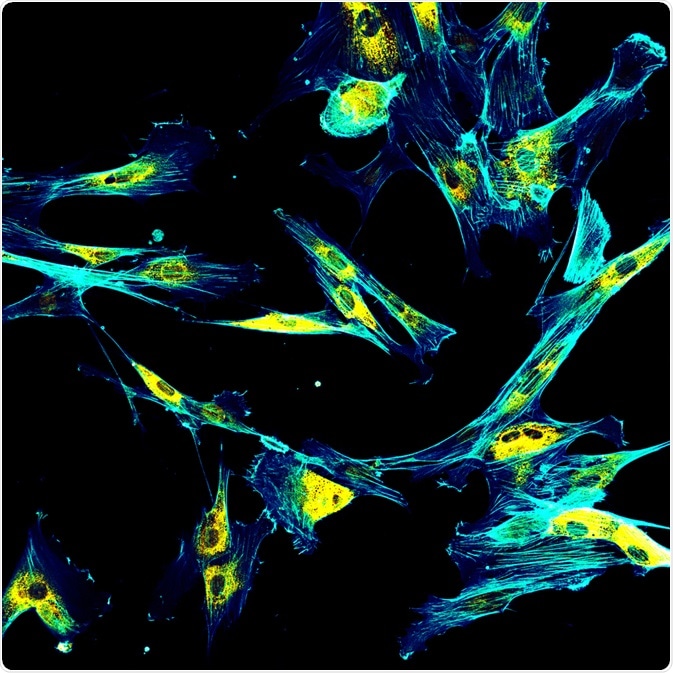Fibroblasts are cells found commonly in the body of humans and other animals, which regulate and maintain connective tissue through the production of fibrous proteins and ground substance.

Image Credit: DrimaFilm/Shutterstock.com
Maintenance of connective tissue
The fibrous proteins and ground substance produced by fibroblasts are what constitute the extracellular matrix (ECM), which makes up the bulk of connective tissue.
The ECM has many roles within tissues. Primarily it provides an elastic structural base for tissue growth to help tissues and organs develop, but it also stores growth factors for when they are needed, transmits mechanical signals within the tissue, and acts as an adhesive substrate.
The fibrous proteins produced by fibroblasts mainly consist of fibrin, fibronectin, and collagen. Fibrin and fibronectin provide a basic framework for cells to stick together and form a tissue, whilst collagen provides the mechanical strength needed for the tissue strength.
Ground substance is simply everything else found within the ECM besides fibrous proteins. It is a transparent gel that fills all gaps between cells and helps the tissue resist compression.
The most common constituent of ground substance is glycosoaminoglycans, which are long, unbranched polysaccharide chains. Proteoglycan is an example of a glycosoaminoglycan, which also has various roles in growth factor propagation and enzyme regulation.
Tissue repair
When tissue becomes damaged, nearby fibroblasts within the connective tissue will migrate to this area and secrete a substance that helps to repair the damage.
This substance is a collagenous matrix, meaning it contains high concentrations of collagen, the main structural protein in the body that boosts the repair of cells and tissues.
Fibroblasts can also change into myofibroblasts when stimulated by a wound, which pulls together the extracellular matrix and helps to close the wound to prevent bleeding.
The ability of fibroblasts to survive in damaged tissues, as well as their growth rate even when isolated, are good reasons why fibroblasts are often grown in culture for studies of cells and tissues.
Fibroblast growth factors
Fibroblast growth factors (FGFs) are a type of polypeptide growth factor that is involved in the repair of damaged tissues such as skin, muscle, nervous tissue, and blood vessels. The first role of FGFs that was identified was that they induce the proliferation of fibroblasts within the damaged tissue.
They now have many more known functions including the promotion of the proliferation of other cell types, such as certain stem cells and bone cells, as well as the migration and differentiation of epithelial cells into cells that also promote tissue repair.
Fibroblasts and cell studies
Fibroblasts are easy to maintain in vitro, and fibroblast cell lines can be easily set up to create viable cell models for the study of diseases. This means they are a very good choice in research for various applications in cell studies.
Certain fibroblasts isolated from skin tissue can also be used to create induced pluripotent stem cells (iPSCs). These cells are invaluable in research as they can be used to create many different other types of cells and are a more ethical way of acquiring stem cells without the need for embryonic stem cells (though embryonic stem cells can create a wider array of cells).
Fibrosis
If fibroblasts become unregulated they can over-produce the collagenous matrix, which leads to the formation of scar tissue. Whilst this is sometimes useful to seal wounds, too much scar tissue leads to a condition called fibrosis.
Fibrosis has a role in any different diseases, including cystic fibrosis, kidney fibrosis, and cardiac fibrosis.
These conditions are all related to the build-up of thick scar tissue within certain organs, which impairs their function. Maintenance of fibroblasts is therefore vital for the health of organs and tissues.
Sources
- Alberts, B., et al. (2002). Fibroblasts and their transformations: the connective-tissue cell family. Molecular Biology of the Cell. https://www.ncbi.nlm.nih.gov/books/NBK26889/
- Midwood, K. S., et al. (2004). Tissue repair and the dynamics of the extracellular matrix. The international journal of biochemistry & cell biology. https://doi.org/10.1016/j.biocel.2003.12.003
- Rozario, T., & DeSimone, D. W. (2010). The extracellular matrix in development and morphogenesis: a dynamic view. Developmental biology. https://doi/org/10.1016/j.ydbio.2009.10.026
- Faculty of Biological Sciences, University of Leeds, (2003). Connective Tissue. https://www.histology.leeds.ac.uk/tissue_types/connective/
- Yun, Y. R., et al. (2010). Fibroblast growth factors: biology, function, and application for tissue regeneration. Journal of tissue engineering. https://doi.org/10.4061/2010/218142
Further Reading
Last Updated: Mar 26, 2020